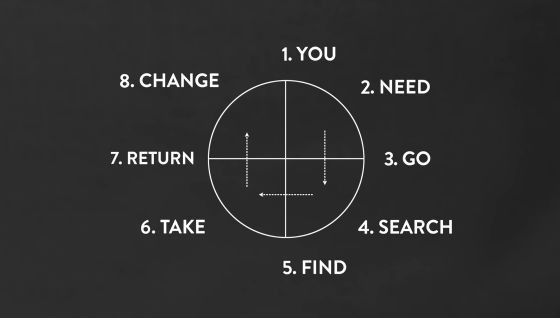"All the stories of movies and novels follow the same rules" theory

Mythologist Joseph Campbell who studied the myths passed on to the world said that "Hero's Journey"The theory was established in 1949. Video essay which simplified this Hero's Journey so that everyone can understand is "Every Story is the Same"is. "Every Story is the Same" is explained using real movies, and it is very easy to understand contents.
Every Story is the Same - YouTube
Mr. Joseph Campbell who set up the Hero's Journey theory.

Hero's Journey is a story that begins with "Call to Adventure" and returns to "Return (with treasure)". Taking the story as a long journey of the hero, rules are defined for each point such as "beginning of change" and "challenge and temptation".

Mr. Dan Harmon further simplified this Hero's Journey.

Mr. Harmon divides the circle of Hero's Journey into four equal parts, "1.YOU" "2.NEED" "3.GO" "4.SEARCH" "5.FIND" "6.TAKE" "7.RETURN" " 8. CHANGE "We defined eight points. The story begins with "1.YOU", it follows the point clockwise and comes back to the departure point via the last "8. CHANGE".

The story involves a great change when moving through each quarterly area. When moving from the upper right to the lower right, "The main character enters the new world and accepts the environment, but difficulties are accompanied by changes in the environment", when moving from the lower left to the upper left, "the hero is mighty It confronts enemies ".

Movement from the lower right to the lower left represents "the hero struggling in an unfamiliar environment overcomes the problem", that is, the growth of the main character.

Mr. Huron said the rule of "going through 4 areas in order and tracing 8 points" into the movie "Star Wars Episode 4 / New Hope"Explanation.

"1.YOU" is an important point of how to make a person look emotion empathic to the hero. In the Star Wars, the droids named R2 - D2 and C - 3PO escape the hands of the imperial army and arrive at the planet Tatooine where they meet the main character Luke Skywalker.

When the story goes into "2.NEED", "something sinister" will occur that turns the environment of the hero. If it is an SF movie with the theme of Earth vs. Aliens, it corresponds to "a scene where a huge spaceship is heading towards the Earth". In Star Wars, Luke who discovered the message asking for help from Princess Leia is the part that invites him to come to Obi - Wan Kenobi, the knight of the Jedi, to come with the Rebel Army.

"3.Go" is a part where the environment enters a new world from the world where hero originally existed, such as "terrorists attack the village of the hero" and "girl moves to new town". In Star Wars, Luke whose parents were killed by the imperial army leaves Tatooen who was born and raised to save Princess Reia, join the Rebel army and beat the Imperial Army. The bigger the gap between "the world where the hero was (peace)" and "the new world (danger)" the bigger the viewer is drawn into the story.

"4. SEARCH" is a part where the hero adapts to the new environment. Luke will do training to become a Jedi in this part, but the Imperial Army will capture it.

"5.Find" is the part where the hero meets "goddess". "Goddess" means various things such as weapons, people, places, etc. What the hero experienced with "4. SEARCH" prepares to meet "goddess". The main character understands what the thing that he is looking for is what it is, and makes a big "selection" which influences the expansion of the story. In Star Wars, the rooks caught by the Imperial Army knew that Princess Leia was caught in the same place, and made a big decision not to respect the dangers found in the Imperial Army "to help the Queen".

"6.TAKE" will be a part paying a large price in exchange for the goddess acquired in "5.Find". However, paying a big price means that the hero will be the key to achieving its ultimate goal. Speaking of Star Wars, Obama-Wan is killed by Darth Vader in exchange for saving Princess Leia. However, thanks to Obi - Wan attracting Darth Vader 's attention, the rooks were able to escape from the Imperial Army.

"7. RETURN" is a simple part that leads to the climax of the story. A scene that runs to the wedding venue to prevent the marriage of a person whose thought is heroous, and fights a terrible car chase with a terrorist corresponds to "7. RETURN". In Star Wars, the Luke who returned to the base of the rebel arm was thinking about the destroy operation of the Death Star of the Imperial army.

The final "8.Change" will be the part where the trip of the story returns to the starting place (peace). However, before "returning to the departure point" "big change" is inevitable. The climax scene of the movie where the hero who reached the wedding venue is connected with the heroine or defeated the leader of the terrorist corresponds to "big change". In Star Wars, Luke used Force's power to destroy Death Star, rescuing the Galaxy from fear and regaining peace.

Mr. Harmon says "All stories are in line with the same rules", but it seems that there are exceptions in many story. After reading the theory of Every Story is the Same, when you read a movie or a novel, you may see new things you have not noticed before.

Related Posts:







